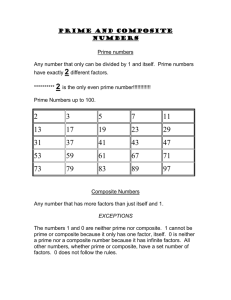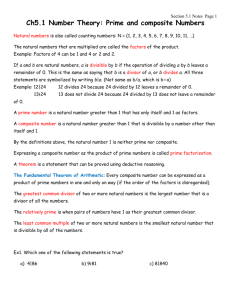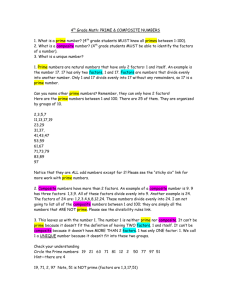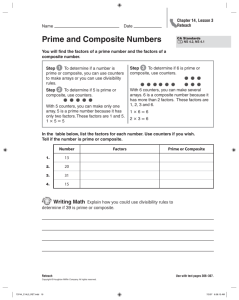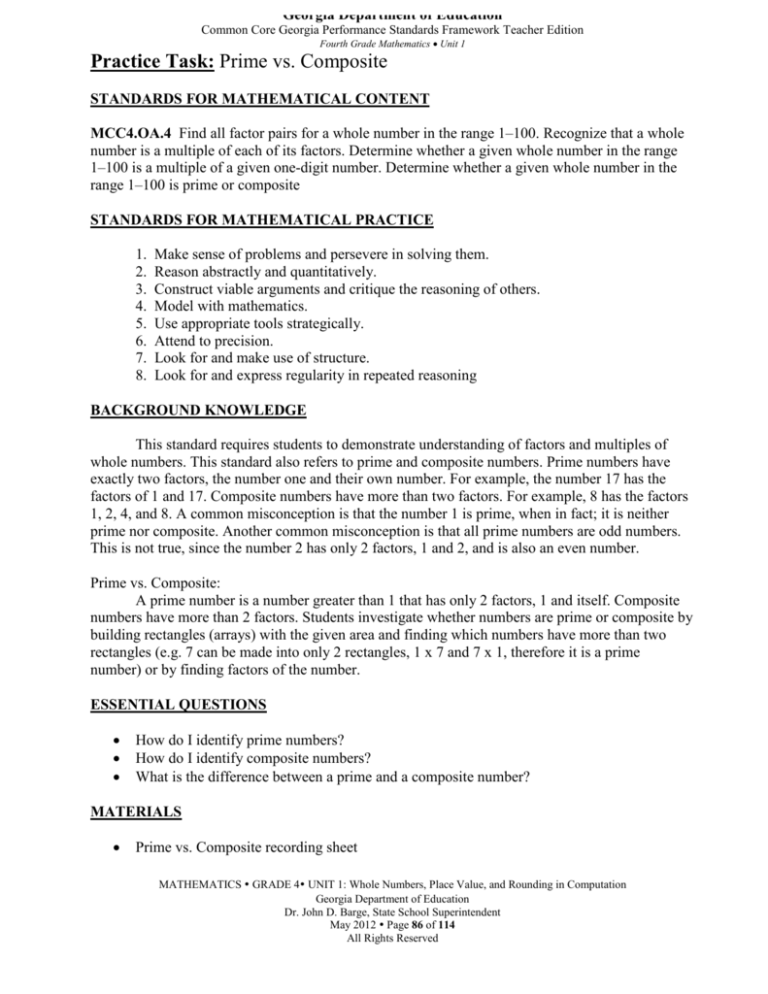
Georgia Department of Education
Common Core Georgia Performance Standards Framework Teacher Edition
Fourth Grade Mathematics x Unit 1
Practice Task: Prime vs. Composite
STANDARDS FOR MATHEMATICAL CONTENT
MCC4.OA.4 Find all factor pairs for a whole number in the range 1–100. Recognize that a whole
number is a multiple of each of its factors. Determine whether a given whole number in the range
1–100 is a multiple of a given one-digit number. Determine whether a given whole number in the
range 1–100 is prime or composite
STANDARDS FOR MATHEMATICAL PRACTICE
1.
2.
3.
4.
5.
6.
7.
8.
Make sense of problems and persevere in solving them.
Reason abstractly and quantitatively.
Construct viable arguments and critique the reasoning of others.
Model with mathematics.
Use appropriate tools strategically.
Attend to precision.
Look for and make use of structure.
Look for and express regularity in repeated reasoning
BACKGROUND KNOWLEDGE
This standard requires students to demonstrate understanding of factors and multiples of
whole numbers. This standard also refers to prime and composite numbers. Prime numbers have
exactly two factors, the number one and their own number. For example, the number 17 has the
factors of 1 and 17. Composite numbers have more than two factors. For example, 8 has the factors
1, 2, 4, and 8. A common misconception is that the number 1 is prime, when in fact; it is neither
prime nor composite. Another common misconception is that all prime numbers are odd numbers.
This is not true, since the number 2 has only 2 factors, 1 and 2, and is also an even number.
Prime vs. Composite:
A prime number is a number greater than 1 that has only 2 factors, 1 and itself. Composite
numbers have more than 2 factors. Students investigate whether numbers are prime or composite by
building rectangles (arrays) with the given area and finding which numbers have more than two
rectangles (e.g. 7 can be made into only 2 rectangles, 1 x 7 and 7 x 1, therefore it is a prime
number) or by finding factors of the number.
ESSENTIAL QUESTIONS
x
x
x
How do I identify prime numbers?
How do I identify composite numbers?
What is the difference between a prime and a composite number?
MATERIALS
x
Prime vs. Composite recording sheet
MATHEMATICS y GRADE 4y UNIT 1: Whole Numbers, Place Value, and Rounding in Computation
Georgia Department of Education
Dr. John D. Barge, State School Superintendent
May 2012 y Page 86 of 114
All Rights Reserved
Georgia Department of Education
Common Core Georgia Performance Standards Framework Teacher Edition
Fourth Grade Mathematics x Unit 1
GROUPING
Individual
TASK DESCRIPTION, DEVELOPMENT, AND DISCUSSION
Students will follow the directions below from the “Prime vs. Composite” recording sheet.
List the factors and draw lines to connect factor pairs. Write P for prime, C for composite, or N for
neither.
What is the only even prime number? Use a diagram to explain how you know the number is
prime.
How can you determine if a number is prime, composite, or neither by looking at the factors of the
number? Explain your answer.
FORMATIVE ASSESSMENT QUESTIONS
x
x
x
x
x
x
What are factors?
How do you know you have found all the factors of that number?
What kind of number has only two factors?
What kind of number has more than two factors?
How do you know this number is prime? Composite?
What kind of diagram will you use to show the only even prime number?
DIFFERENTIATION
Extension
x Have students investigate using the counters to determine if 1 is prime or composite.
Intervention
x Provide students with a list of numbers which are prime and a list of numbers which are
composite. Have students prove the numbers are on the correct list by making arrays to
determine the number of ways each number can be made.
MATHEMATICS y GRADE 4y UNIT 1: Whole Numbers, Place Value, and Rounding in Computation
Georgia Department of Education
Dr. John D. Barge, State School Superintendent
May 2012 y Page 87 of 114
All Rights Reserved
Georgia Department of Education
Common Core Georgia Performance Standards Framework Teacher Edition
Fourth Grade Mathematics x Unit 1
Name ________________________________________ Date ___________________________
Prime vs. Composite
List the factors and draw lines to connect factor pairs. Write P for prime, C for composite, or N for
neither.
Number
Factors
P, C, or N
1. 8
2. 19
3. 30
4. 1
5. 42
6. 29
7. What is the only even prime number? Use a diagram to explain how you know the number
is prime.
8. How can you determine if a number is prime, composite, or neither by looking at the factors
of the number? Explain your answer.
MATHEMATICS y GRADE 4y UNIT 1: Whole Numbers, Place Value, and Rounding in Computation
Georgia Department of Education
Dr. John D. Barge, State School Superintendent
May 2012 y Page 88 of 114
All Rights Reserved


